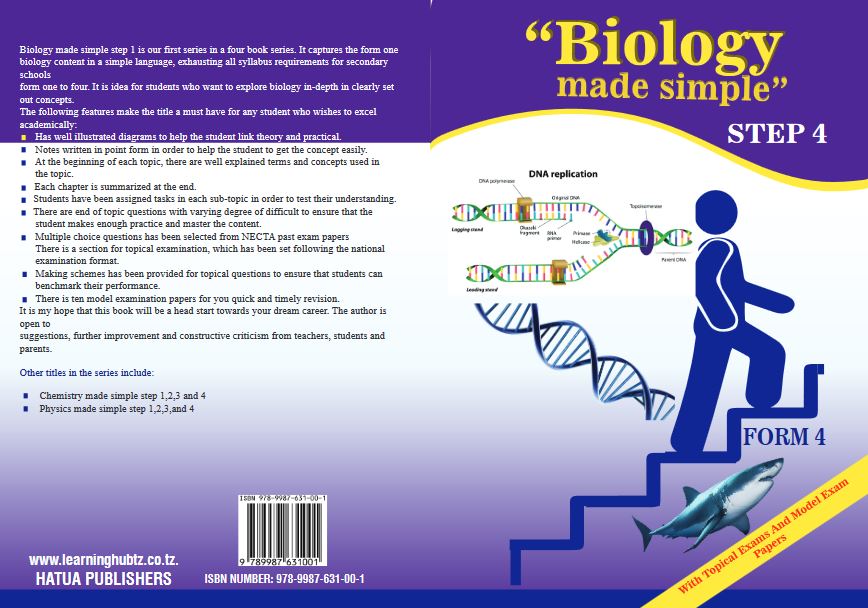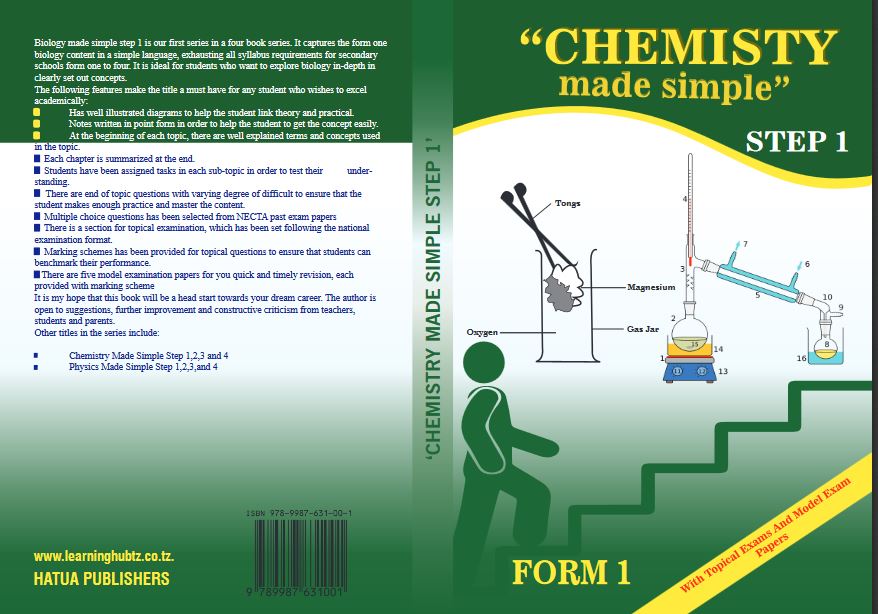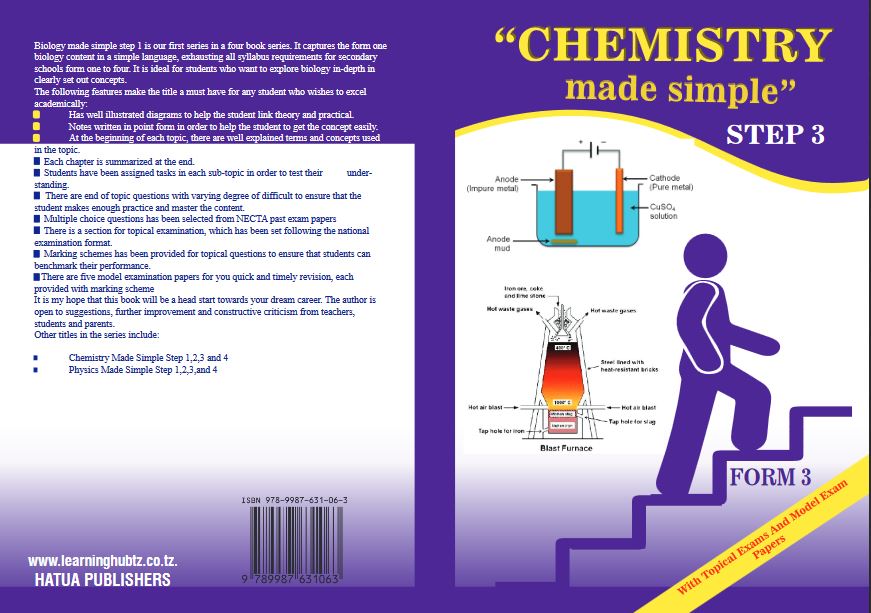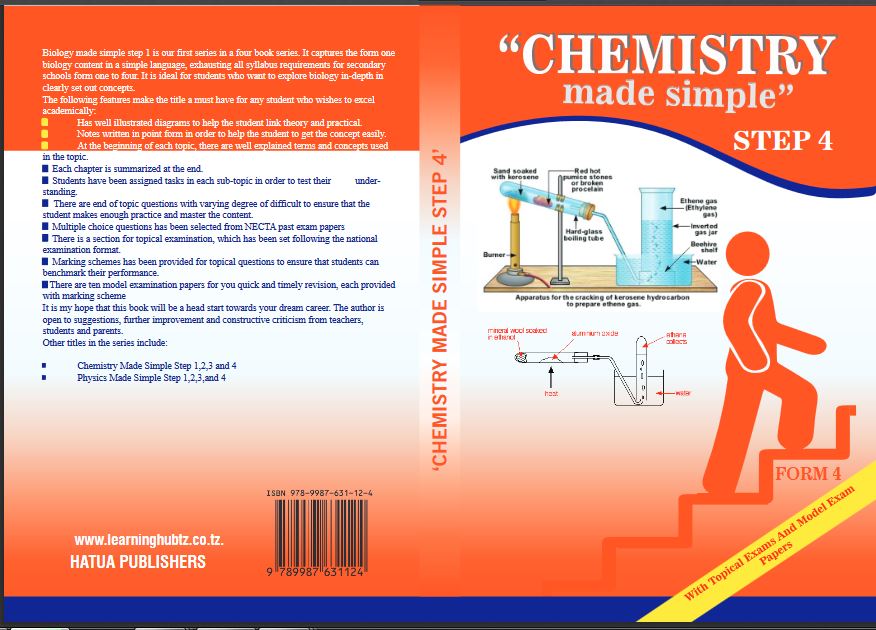THE PRESIDENT’S OFFICE
REGIONAL ADMINISTRATION AND LOCAL GOVERNMENT
FORM THREE ANNUAL EXAMINATION
BIOLOGY
TIME: 3 HOURS NOVEMBER 2024
Instructions
1. This paper consists of sections A, B and C with a total of ten (10) questions.
2. Answer all questions. All answers must be written in the spaces provided.
3. Section A and C carry fifteen (15) marks each and section B carries seventy (70)
marks.
4. All writings must be in blue or black ink except drawing which must be in pencil.
5. All communication devices, calculators and any unauthorized materials are not
allowed in the Mock Assessment room.
6. Write your Mock Assessment Number at the top right corner of every page.
SECTION A (15 Marks)
Answer all questions in this section.
1. For each of the items (i)-(x), choose the correct answer from among given alternative and write its latter in booklet given.
i. Nyerere observed using a microscope an organism moving by help of Pseudopodia. This organism is likely to be
A. Amoeba
B. Euglena
C. Paramecium
D. Plasmodium
E. Spirogyra
ii. A problem of hiccup can be solved by
A. Drinking enough amount of water
B Eating enough food
C. Reducing amount of carbondioxide
D. Swallowing large amount of air
E. Taking small amount of water
iii. In order to maintain proper health to individual the following factors should be practical except
A. Have time for break and leisure
B. Practical regular physical exercise
C. Reduce unhealthy food intake
D. Sleep in well-ventilated room
E. Take medical drugs regularly
iv. What happens to blood cell when put into a solution which higher concentration of glucose?
A. Glucose enter blood cells from glucose solution
B. Glucose leave the glucose solution into blood cells
C. Water and glucose leave blood cells at equal rates
D. Water enters the blood cell form glucose solution
E. Water leave the blood cell into glucose solution
v. A cross-section ally cut stem was immersed in Iodine solution for five minutes and appeared to have a blue black colour. Which part of the stem stained blue black?
A. Cambium
B. Endodermis
C. Pericycle
D. Phloem
vi. Identify one adaptation of human respiratory system in its role
A. Has a nostril that allow passage of gases
B. Has cilia for trapping dust and germs
C. Has hairs for capturing micro-organism
D. It is moist to allow mucus secretion
E. Produces mucus to warm entering hair
vii. During a camping trip, a friend experience an insect bite with mild swelling and redness which component of first Aid would you be most beneficial for initial relief
A. Anti-histamine cream
B. Instant cold pack
C. Alcohol wipe
D. Elastic Bandage
E. Triangular Bandage
viii. An organelle found both plant and animals cell known as power house of cell for energy generation from food molecule is
A. Vacuole
B. Golgi
C. Cell-wall
D. Mitochondria
E. Chloroplast
ix. Which of the following is the end product of starch digestion in duodenum.
A. Glucose
B. Amine Acid
C. Fats
D. Maltose
E. Peptide
x. All things around an organism makes up its
A. Ecosystem
B. Abiotic Component
C. Biotic component
D. Niche
E. Natural environment
2. Match the items in LIST A with correct response in LIST B by writing its letter below item number.
| LIST A | LIST B |
| i. Structure for gaseous exchange in humans ii. Structure which trap dust in Trachea iii. Structure which protect lungs from injury iv. Process which release energy in absence of oxygen v. Organism which break down sugar to carbon dioxide and alcohol vi. Accumulated of lactic acid in muscles | A. Anaerobes B. Aerobic respiration C. Anaerobic respiration D. Ribs E. Larynx F. Cilia G. Bronchiole H. Alveoli I. Yeast J. Oxygen debt |
SECTION B 70 marks
Answer all questions
3. a) Identify the organism which are used for gaseous exchange for the following organism
i. Cow
ii. Frog
iii. Maize leaf
iv. Fish
v. Earth worm
b) The figure below shows experimental set-up to investigate various aspect of gaseous exchange.

Answer the following questions
i. What aspect of gaseous exchange is experiment designed to investigate?
ii. Explain function of Lime water
iii. Explain why Lime water in test tube B turned Milky
iv. Explain why there was no change in test tube A
v. Describe the term gaseous exchange
4. i) Explain why people urinate frequently after taking alcohol
ii) Determine the pathway of water reabsorption in nephrons and determine hormone affected by alcohol
5. a) State three actions which take place in human body in response to each of the following
i. When temperature of surrounding is low
ii. When body temperature rise due to increase in surrounding temperature
b) Briefly explain why people look pale when they fell cold
6. a) Explain two significance of reproduction
b) Explain why it is not possible for insect to visit and pollinate wind pollinated flower
7. a) Plant dispersed its seeds Naturally. The seedling formed were examined two weeks later. They were found is differ in height. Suggest three environment factor which caused the difference.
b) Explain factors that may hinder fertilization in humans
8. Digestion of food materials in the Ileum produces end product by help of various enzymes. Justify
SECTION C (30 MARKS)
Answer any two questions
9. a) Mr. Juma a biology teacher at Kibuzu secondary school put a piece of bread on a wet cup board after a few days certain gray substance were observed to grow on a piece of bread .
i. Name the organism that grow on bread surface
ii. Name the kingdom in which the observed organism belongs
iii. List any three advantage of Kingdom to which the organism named above belong.
b) Animals are considered to be Heterotrophs while plants are said to be autotrophs
i. Name the process that make plants to be called autotrophs
ii. Write chemical equation for process above
iii. What will happen if the process does occurs in environment?
10. Most women prefer bottle breast feeding currently. Advice them on advantage of breast feeding.
11. On his way home, Mohammed heard a loud voice of lion. Describe the mechanism which enabled James is hear the voice.
LEARNINGHUBTZ.CO.TZFORM THREE BIOLOGY MODAL SERIES 40
PRESENT’S OFFICE, REGIONAL ADMINISTRATION
AND LOCAL GOVERNMENT
SECONDARY EXAMINATION SERIES
COMPETENCY BASED EXAMS
BIOLOGY FORM THREE
ANNUAL EXAMINATIONS- 2023
TIME: 2:30 HRS
INSTRUCTIONS
1. This paper consists of section A, B and C with a total of eleven (11) questions
2. Answer all questions in section A and B and two (2) questions from section C.
3. Section A carries sixteen (16) marks, section B carries fifty four (54) marks and section C carries thirty (30) marks.
4. All writings must be in blue or black ink except drawings which should be in pencil.
5. All communication devices, programmable calculators and any unauthorized materials are not allowed in examination room.
6. Write your examination number on every page of your answer sheet(s).
SECTION A (16 MARKS)
- For each of the following items (i) – (x) Choose the most correct answer correct answer from among given alternatives given.
- After visiting Tarangire National parks, Peter saw organism which had similar feeding habit. What term can be used to describe this organism?
- Community
- Trophic level
- Food chain
- Food web
- Habitat
- Monica found an Organism shaped like an umbrella in a damping site. Which statement is true about the organisms?
- It is a mushroom and belongs to phylum Ascomycota
- It is yeast and belongs to phylum Basidiomycota
- It is mushroom and belongs to phylum Basidiomycota
- It is Mucor and belongs to phylum Ascomycota
- It is Yeast and belongs to phylum Ascomycota.
- David, A bus driver was preparing items for his first Aid Kit Which one did she not include?
- A pair of scissors
- Touch
- Sterilized cotton wool
- Amoxylin Tablets
- Juma ate a meal consisting of protein. Where did the digestion of the meal begum?
- Mouth
- Duodenum
- Stomach
- Small intestine
- Ileum
- During an investigation a form II student put a piece of bread in a wet cupboard, after a few days the bread was covered with grayish substance. What are the name of the substance?
- Penicillium
- Rhizopus stononifer
- Entamoeba histolytic
- Agaricus compestris
- Saccharomyces cerevisiae
- In a motor car accident the bus driver found that he could hardly maintain equilibrium, which of the structure was damaged?
- Semi-circular canal
- Fore brain
- Medulla Oblangata
- Eustachian Tube
- The cochlea
- Dr. Nambena received medical results from laboratory and identified that the victim suffered from filicidal woman infection. Which of the following disease is typical caused by above worms?
- Lymphloma
- Elephantiasin
- Oedema
- Thrombosis
- Arteriosclerosis
- The glomenulars filtrate contains the following materials
- Glucose molecules, water, urea and dissolved mineral salt
- Cells, protein and glucose
- Uric acid, proteins and urea
- Vitamin, urea and water
- Mineral salts, proteins and glucose
- The part of ear which convert sound signals into nerve impulse which are transmitted to brain include
- Ear Ossicles
- Semicircular canal
- Cochlea
- Eustachian Tube
- Ear dram
- The part of compound Microscope which help to concentrate light into beams to
- Ocular tube
- Condenser
- Mirror
- Revolving nosepiece
- Diaphragm
- Match items from LIST A with correct phrase in LIST B by writing the letter of correct response from LIST B against item number in LIST A.
| LIST A | LIST B |
|
|
SECTION B (54 MARKS)
Answer all questions in this section
- (a)Give three factors that Aid in Ultra filtration in the glomenulars
(b)Give explanation of the following
- Plasma proteins are absent in glomerular filtrate
- Urine of a normal person does not have glucose
- During cold days one produces large quantities of dilute Urine
(c) State 3 adaptation of convoluted tubule to re-absorption
- (a)Sate any three adaptations of the leaf to photosynthesis
(b)How do the following factors affect rate of photosynthesis
- Chlorophyll
- Sunlight
- Carbon dioxide
- (a) During cooking a cook unfortunately touched a hot charcoal burner. He pulled in hand abruptly.
- What is the name of that response
- What is the name given to pathway which describe response in 8a(i) above
(b) Illustrate the pathway of an impulse from the sense organs to effectors of the cooks’ hand
- Juma visited Mikumi National park and saw the following organisms, Zebra, giraffe, lion grasses, Mushroom, hyena and antelope.
- Construct two (2) food chains from organism observed in the National park
- Construct a simple food web
- Identify organism which are
- Producer
- Secondary consumer
- Decomposer
- (a)Draw a diagram of maize cell and label the parts responsible for the following functions.
- Control all activities of cell
- Provide shape of the cell
- Chemical reaction occur here
(b)How is maize cell different from cell of a goat?
- (a)A flower was found to have conspicuous petals scented and firmly held stigma and anthers
- What is likely agent of pollination of the flower?
- What is the significance of firm held stigma in the flower?
(b)Briefly explain the rule the following structures in flowers
- Petal
- Stigma
- Ovary
- Style
- Anther
SECTION C (30 MARKS)
Answer two (2) questions in this section
- (a)Explain why
- The rate of breathing increase quickly during exercise
- Is better to breathe through nose than through mouth
(b)How are respiratory surface adapted to their role?
- Many people believe that fungi are harmful organism. As biologist, explain six ways in which fungi are beneficial to humans
- Humans in their daily life come into contamination with viruses, bacteria, worms, and other pathogens explain any six ways used by humans to prevent invasion and infections by disease causing micro-organisms.
LEARNINGHUBTZ.CO.TZFORM THREE BIOLOGY MODAL SERIES 34
THE PRESIDENT'S OFFICE
MINISTRY OF REGIONAL GOVERNMENT AND LOCAL GOVERNMENT
AUGUST-SEPTEMBER EXAMINATION SERIES
BIOLOGY FORM-3
2020
TIME: 2:30 HRS
Instructions
- This paper consists of sections A, B and C with a total of fifteen (15) questions.
- Answer all the questions in sections A and B and two (2) questions from section C of which question 13 is compulsory.
- All writing should be in blue or black pen, except for diagrams that must be drawn in pencil.
- Cellular phones and any unauthorised materials are not allowed in the examination room.
- Write your Examination Number on every page of your answer booklet(s).
SECTION A (15 Marks)
Answer all questions in this section.
1 For each of the items (i) - (x), choose the correct answer from among the given alternatives and write its letter beside the item number in the answer booklet provided.
(i) What is the aim of doing experiment when conducting a scientific investigation?
- Identifying a problem
- Finding a solution
- Testing a hypothesis
- Gathering information
- Recording results
(ii) What is the role of node of ranvier in a neurone?
- To transmit the impulses away from the cell body.
- To insulate the axon and speed up transmission of impulses.
- To transmit nerve impulses from one nerve to another.
- To speed up the transmission of nerve impulses.
- To transmit the nerve impulses towards the cell body.
(iii) flow many gametes are produced from one cell during meiosis?
- Eight
- Two
- Four
- Six
- Ten.
(iv) Which of the following is the excretory organ in human?
- Mouth
- Kidney
- Pancreas
- Stomach
- Anus.
(v) The function of the bright coloured petals in flowers is
- to store nectarines
- to hold sepals in position
- to produce colour of the flower
- to receive pollen grain
- to attract insects for pollination.
(vi) The function of hydrochloric acid in food testing experiment is
- to decolourise food sample
- to test reducing sugar
- to oxidize the food sample
- to neutralize sugary foods
- to hydrolyze complex to simple sugar.
(vi) Goitre is a deficiency disease caused by lack of which element in the diet?
- Carbohydrate
- Iodine
- Vitamin E
- Vitamin C
- Protein.
(vii) The product of anaerobic respiration process in animals is
- lactic acid
- carbondioxide
- alcohol
- water
- oxygen.
(viii) Which disease spread rapidly as a result of poor waste disposal?
- Anemia
- AIDS
- Cholera
- Leukemia
- Small pox.
(x) A voluntary muscle that is capable of relaxing continuously and do not fatigue easily is known as
- skeletal muscle
- biceps
- triceps
- cardiac muscle
- smooth muscle.
2. Match the responses in List B with the phrases in List A by writing the letter of the correct response from List B beside the item number of List A in your answer booklet.
| LIST A | LIST B |
|
|
SECTION B (60 Marks)
Answer all questions in this section.
3. (a) Differentiate the term "Biological apparatus" from "Biology Laboratory".
(b) Briefly explain why the following substances are dangerous?
- Toxic substances
- Highly flammable
- Corrosive substances
- Radioactive substances.
4. (a) State two principles of waste disposal.
(b) Suggest three proper ways of waste disposal in the community.
5. (a) Explain the distinctive features of the Division Filicinophyta.
(b) Draw a well labeled diagram of a fern plant.
6. (a) List any two types of blood cells.
(b) Give two differences between arteries and vein.
7. (a) State three basic principles of waste disposal.
(b) Why poor waste disposal at home is said to cause adverse effects?
8. (a) Give the meaning of the following terms:
- Vegetative propagation.
- Gamete.
(b) Explain the merits and demerits of asexual reproduction in plants.
9. (a) Define the term “osmoregulation”.
(b) Briefly explain the mechanisms of regulating sugar level in the blood.
10. (a) Explain the functions of the vascular system in plants
(b) State three importance of transportation of materials in living things.
11. Consider that you are a medical doctor and you have received a patient whose investigation has diagnosed kidney stones. Suggest to the patient three possible causes and three control measures for kidney stones.
12. Reptiles are organisms whose body temperature is affected by environmental temperature. Briefly explain three ways that help reptile to survive in different weather conditions.
SECTION C
13. Explain any four effects of irresponsible sexual behaviour and suggest five ways of eradicating those behaviours in the community.
14. Describe four similarities and seven differences between insect and wind pollinated flowers.
15. Write an essay on transportation in plants using the following guidelines:
- Meaning of transportation
- The importance of transpiration
- The adaptation of features which enable plants to reduce water loss
LEARNINGHUBTZ.CO.TZFORM THREE BIOLOGY MODAL SERIES 27
LEARNING HUB TANZANIA
BIOLOGY - TERMINAL EXAMINATION
FORM THREE
TIME: 3HRS
NAME: __________________________________ CLASS:___________
- INSTRUCTIONS
i) This paper consists of three sections A,B and C
ii) Answer all questions in sections A and B, and one question in section C
iii) Ensure clarity in your responses
iv) Don’t attempt to cheat
- Regulatory control of the body temperature thirsty and hunger occurs in the
- Hypothalamus
- Cerebrum
- Thalamus
- Pituitary
- Hyposecretion of growth in childhood would result to….
- Dwarfism
- Gigantism
- Death
- Hyperactivity
- A student was given a piece of material of doubtful origin; he wanted to know whether it is from an animal or from a plant. Which of the following should be analyze and examine?
- The cytoplasm and cell membrane
- The nucleus and outermost covering
- The cytoplasm and outmost covering
- The nucleus and cell membrane
- Plasmolysis of red blood cells would occur if the cells were
- In isotonic solution
- In hypotonic solution
- In hypertonic solution
- Non of the above
- The following are ascomycota except one identify it
- Cup fungi
- Penicillum
- Yeast
- Rhizopus stolonifer
- The skin does all these except;
- Regulate temperature
- Produce blood cells
- Store fat
- Prevent you from ultra-violet rays
- All are functions of saliva except;
- Digestion of starch
- Digestion of protein
- Lubrication of food
- Protection of bacteria
- Which part constitutes an illuminating system?
- Diaphragm
- Mirror
- Condenser
- All of the above
- Which of the following statements concerning diffusion and active transport is correct?
- Both require energy
- Neither requires energy
- Only diffusion requires energy
- Active transport requires energy while diffusion do not
- On a cold day one usually experiences, shivering, this is the way of maintaining normal body temperature. Why does one feel better after shivering?
- The muscles are coordinated
- The body responds to stimulus
- The body releases energy and heat
- The body has better adaptations
- Match the responses in list B with the phrases in list A by writing the letter of the correct response from list B beside the item number of list A in your answer booklet.
| LIST A | LIST B |
| i) Receives impulses and gives appropriate response to stimuli ii) A gap through which impulses pass when travelling from one neuron to another iii) Receives impulse from the external stimuli and transmits it to the spinal cord iv) Controls and coordinate body balancing organs, thus making accurate movement possible v) The nervous pathway taken by impulse in reflex action vi) Transmits impulse away from the spinal cord vii) Controls involuntary action such as heart beat, breathing, sneezing and swallowing viii) Transmit impulse within the spinal cord ix) Concerned with reasoning, intelligence and judgment x) Controls the pituitary gland |
|
SECTION B
Answer all questions in this section
All questions carry 8 marks except question five and six which carry 6 marks each.
- a)State three actions which take place in the human body in response to each of the following conditions:
i) When the temperature of the surrounding is low
ii) When the body temperature rises due to increase in surrounding temperature
b) Briefly explain why people took pale when they feel cold?
- i) The diagram below represents a mammalian nephron
a) What happens to sodium ions between sections 1 and 2?
b) Explain the effect of the absence of the ant diuretic hormone to the functioning of section3
c) What would happen if there is partial constriction at point 5?
d) Explain the difference in structural adaptations of a desert animal such as kangaroo and a water fish such as tilapia nilotica.
ii) Study the diagram below and answer the question that follows
a) Name the structures labeled A,C,E, and F
b) State the function of structure labeled D
c) If structure F was removed from the body of the mammal, what effect would this have?
- a)Define the term photosynthesis
b) Give the importance of photosynthesis
c) List four differences between respiration and photosynthesis
d) State the site of photosynthesis in a plant cell
e) What role is played by light during photosynthesis?
- a)Explain the functions of the vascular system in plants
b) State three importance of transportation of materials in living things
- The diagram given below represents a limb of a vertebrate
a) Name the bones labeled A,B and C
b) Name the parts D, and A
c) State the functions of D, and E
d) A patient was operated and doctors realized that the synovial fluid in the joints had reduced. Suggest a possible effect of this.
ii) The diagram below shows the behavior of red blood cells when placed in various solutions
a) Name the process that takes place in C and F
b) What types of solutions are A,B and C
c) If a plant cell were placed in a beaker containing solutions A, what observations are likely to be made?
d) Which of the solution is likely to be found in a blood plasma?
- a)Draw a large and neat labeled diagram of the villus found in the digestive system
b) i) Name the digestive juice which is produced by the liver
ii) State the function of the substances contained in the digestive juice named in b (i)
- a)Differentiate the following terms:
i) Breathing and respiration
ii) Inhalation and exhalation
b) Briefly describe the following phenomenon:
i) A person breathes more when is running fast
ii) The ribs move outwards and upwards while the diaphragm flattened when air enters the lungs
SECTION C (20 MARKS)
Answer one (1) question from this section
- Explain any four effect of irresponsible sexual behavior and suggest five ways of eradicating those behaviors in the community.
- Describe how malaria parasites are transmitted, the sign developed to the host and give four ways which can help in combating malaria in the country.
- Explain two differences between artificial and natural classification systems and indicate the two merits and demerits for each system.
1
LEARNINGHUBTZ.CO.TZFORM THREE BIOLOGY MODAL SERIES 14
 For Call,Sms&WhatsApp: 255769929722 / 255754805256
For Call,Sms&WhatsApp: 255769929722 / 255754805256
 For Call,Sms&WhatsApp: 255769929722 / 255754805256
For Call,Sms&WhatsApp: 255769929722 / 255754805256






